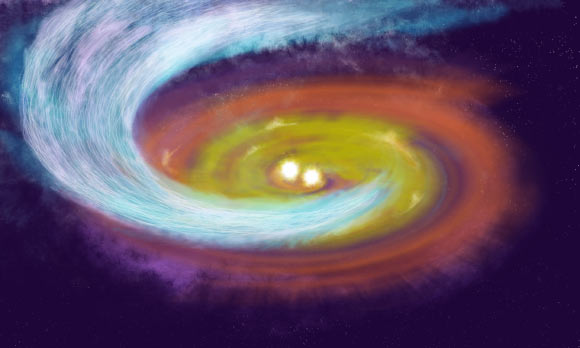This streamer of gas is channeling matter from the surrounding cloud of a star-forming region in Perseus directly onto a newborn binary star system called SVS 13A.
Stars are born from clouds of gas and dust, but recent observations show star birth is far more dynamic than previously thought.
The new data from the Atacama Large Millimeter/submillimeter Array (ALMA) captured both the dust and molecules swirling around the SVS 13A system, revealing that magnetic fields don’t just thread through these stellar nurseries — they actively steer the flow of material, providing a preferred route for gas to travel onto the disk where new stars and planets form.
“Imagine a garden hose, but instead of water it’s smoothly delivering star-building material through a winding path carved by invisible forces,” said Dr. Paulo Cortes, an astronomer at NSF’s National Radio Astronomy Observatory and the Joint ALMA Observatory.
“That’s the picture emerging from the ALMA observations: a channel of gas, dubbed a sub-Alfvénic streamer, regulated by spiral magnetic field lines.”
“These new data give us a new window into star formation.”
“This streamer shows how magnetic fields can regulate star formation by shaping the infall of material, like a dedicated highway for the cars to move along.”
The ALMA images and data reveal two spiral arms of dust encircling the stars, with a streamer of gas that closely follows the same path.
This remarkable alignment suggests gas in the streamer moves slowly compared to what was previously believed, supporting the idea of a magnetized channel rather than a turbulently collapsing cloud.
The fact that such a streamer exists and connects the cloud to the disk — feeding material in a controlled way — means that gravity and magnetism both play crucial roles in building stars and shaping the planets that may eventually form around them.
This pioneering result marks the first time astronomers have directly mapped both the streamer and its guided magnetic field in a single observation.
“The sub-Alfvénic streamer suggests a new role for the magnetic field when gravity dominates, where it acts as a ‘guide’ facilitating the infalling of material from the envelope onto the disk,” the astronomers said.
The findings appear this week in the Astrophysical Journal Letters.
_____
P.C. Cortés et al. 2025. First Results from ALPPS: A Sub-Alfvénic Streamer in SVS 13A. ApJL 992, L31; doi: 10.3847/2041-8213/ae0c04








